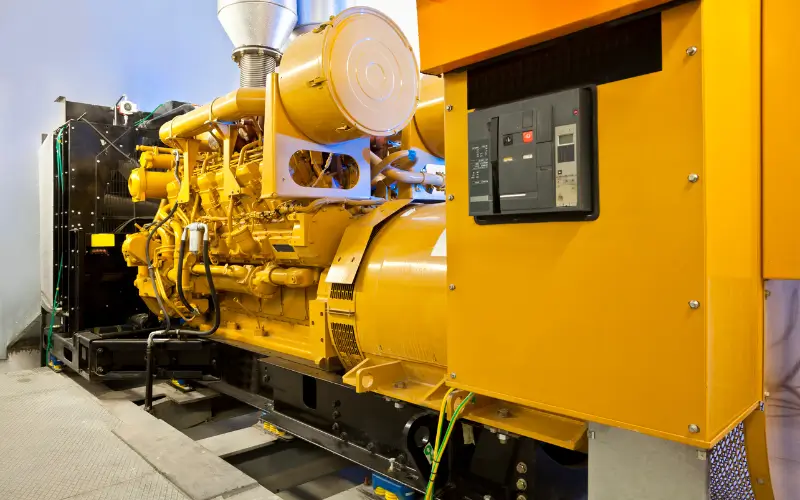Fuel costs are one of the most significant ongoing expenses when operating generators, whether for industrial, commercial, or off-grid residential use. With rising diesel and gasoline prices and increasing pressure to reduce operating costs, optimizing generator fuel consumption has never been more crucial.
But here’s the challenge: Most generators run inefficiently—often oversized, underloaded, or poorly maintained—leading to wasted fuel and higher costs. Fortunately, by applying the right generator optimization techniques, you can drastically cut down on fuel usage without compromising performance or reliability.
In this comprehensive guide, we’ll explore practical, proven techniques to optimize your generator setup. From smart sizing and load management to advanced control technologies and hybrid systems, you’ll gain actionable insights to help you achieve maximum fuel efficiency and cost savings.
Right-Sizing Your Generator
One of the most overlooked—yet most impactful—ways to reduce generator fuel costs is to ensure the generator is correctly sized for your needs. A generator that’s too big or too small for the load it supports can waste a surprising amount of fuel and increase long-term operating costs.
Why Generator Size Matters
Generators are designed to run efficiently within a specific load range, typically between 70% and 80% of their rated capacity. If your generator is consistently running below or above this optimal range, it will burn more fuel than necessary.
- Oversized generators run under-loaded most of the time. This causes “wet stacking,” inefficient fuel burn, carbon buildup, and unnecessary wear—all while wasting fuel.
- Undersized generators are forced to operate near or at full capacity constantly, leading to overheating, faster degradation, and higher maintenance needs.
The result in both cases? More fuel consumption and higher costs.
How to Calculate the Right Size
To right-size your generator, start by calculating the actual load requirements of your operation:
- List all connected devices – Identify every piece of equipment or appliance powered by the generator.
- Record power ratings – Use wattage or kilowatt ratings for each device. For motors or devices with startup surges, include peak (starting) wattage.
- Calculate total demand – Add up all running wattages. Add a buffer of 15–25% for surge protection and future expansion.
Example:
Equipment total: 10 kW
Surge buffer: +2 kW
Minimum generator size: 12 kW (at 80% load, you’d need ~15 kW generator)
Variable-Speed Generators: A Modern Alternative
Traditional fixed-speed generators run at a constant RPM (usually 1800 or 3600), regardless of load. This is highly inefficient during low-load conditions.
Variable-speed generators, on the other hand, automatically adjust their RPM to match real-time power demand. This not only saves fuel but also reduces noise and wear.
- Ideal for variable or intermittent loads
- Especially useful in hybrid or renewable-integrated systems
Tools and Services That Can Help
- Load assessment calculators (available online from generator manufacturers)
- Professional load studies or energy audits
- Remote monitoring systems for ongoing load tracking and analysis
Load Management Strategies
Even if your generator is properly sized, poor load management can sabotage your fuel efficiency. The way power is distributed, balanced, and prioritized directly impacts how hard your generator has to work—and how much fuel it consumes.
Effective load management isn’t just about reducing consumption. It’s about ensuring your generator operates within its optimal efficiency range as often as possible.
Operating Within the Ideal Load Range (70%–80%)
Generators operate most efficiently when they’re running at 70% to 80% of their rated load. Operating below 30% load for extended periods leads to incomplete combustion, carbon buildup, and wasted fuel (known as “wet stacking”). On the flip side, running at 90%+ continuously increases wear and fuel consumption.
Solution: Schedule high-power equipment to run during peak generator efficiency periods. If your load is too low, consider redistributing or cycling tasks to boost it temporarily.
Load Bank Testing
If your generator often runs under light loads (like during standby operations), load bank testing is essential.
- Simulates a full-load environment for testing
- Burns off carbon deposits and moisture buildup
- Verifies generator performance under optimal load conditions
Recommended: Perform load bank testing every 6 to 12 months for standby generators that rarely see full capacity.
Smart Load Shedding
Load shedding means prioritizing essential systems and disconnecting or delaying non-essential ones when demand spikes.
Use cases:
- Avoid generator overload
- Maintain load balance during peak hours
- Minimize fuel burn by shutting down unnecessary loads automatically
Modern control panels or automatic transfer switches (ATS) can automate this process, ensuring high-priority systems always get power while shedding non-critical loads during strain.
Load Balancing Across Phases
For three-phase generators, unbalanced loads across the phases can create inefficiencies and mechanical stress.
- Even distribution of load prevents phase imbalance
- Reduces vibration, overheating, and fuel waste
Parallel Generator Operation
Running two or more smaller generators in parallel can be more efficient than using one large unit—especially if your power demands fluctuate significantly.
Benefits:
- Allows you to turn off one generator during low demand
- Improves redundancy and reliability
- Reduces fuel consumption during off-peak times
For example, two 10 kW generators could be used alternately or together, depending on load, instead of one 20 kW generator constantly running below capacity.
Use of Automated Load Controllers
Advanced load control modules or generator controllers can:
- Monitor load conditions in real time
- Automatically start/stop generators
- Shift loads across units for maximum efficiency
These systems are common in critical facilities, hybrid setups, and large-scale backup systems, but they’re becoming more accessible for small businesses and remote homes too.
Regular Maintenance & Fuel Quality
Even the most efficient generator will waste fuel if it’s poorly maintained or running on contaminated fuel. Over time, dirt, wear, and neglect can reduce efficiency by 10–20% or more, causing the generator to consume significantly more fuel than necessary.
That’s why regular maintenance and attention to fuel quality are essential pillars of generator optimization.
Routine Service Checks: Your First Line of Defense
Regular servicing ensures your generator operates at peak efficiency. Follow the manufacturer’s service intervals, and don’t wait for performance issues to arise before performing basic maintenance tasks.
Key Areas to Maintain:
- Air Filters: Clogged filters restrict airflow, causing incomplete combustion and higher fuel consumption.
- Oil & Oil Filters: Dirty oil increases friction and reduces engine efficiency. Change oil per recommended intervals.
- Fuel Injectors: Dirty or malfunctioning injectors lead to poor spray patterns and fuel waste.
- Coolant System: Overheating reduces performance. Keep coolant levels topped off and check for leaks.
Fuel Quality: A Silent Efficiency Killer
Low-quality or stale fuel can clog injectors, reduce combustion quality, and even damage the engine. If your fuel is old, contaminated, or poorly stored, it will hurt your generator’s performance and increase consumption.
Tips for Fuel Management:
- Use high-quality fuel from reputable sources.
- Add stabilizers if fuel will sit for more than 30–60 days.
- Drain sediment and water from the fuel tank regularly.
- Keep tanks sealed to minimize moisture buildup (especially for diesel).
- Consider biocide treatments to prevent algae growth in diesel tanks.
Optimize Cooling & Ventilation
A generator operating in high ambient temperatures or poor ventilation conditions will struggle to cool itself, reducing efficiency and increasing fuel use.
Best Practices:
- Ensure adequate airflow around the generator
- Clean radiator fins and fans regularly
- Keep the exhaust system free of obstructions
- Avoid placing generators in enclosed or unventilated spaces
Use Diagnostic Tools for Precision
Modern generators often come equipped with diagnostics that track:
- Runtime hours
- Fuel burn rates
- Engine temperature
- Error codes and service alerts
Use this data to predict maintenance needs and optimize service timing to avoid reactive, fuel-wasting issues.
Advanced Control Technologies
Modern generators have come a long way from being simple, manual-start machines. Today, advanced control technologies can dramatically enhance operational efficiency, reduce fuel consumption, and even automate key functions based on real-time demand.
If you’re serious about cutting fuel costs, integrating intelligent control systems should be a top priority.
What Are Generator Control Technologies?
Control technologies refer to the hardware and software systems that monitor, manage, and optimize generator performance. These can range from basic digital control panels to sophisticated remote monitoring systems and smart automation platforms.
They allow you to:
- Monitor fuel usage
- Adjust output based on demand
- Automate start/stop cycles
- Detect and respond to faults quickly
- Track long-term performance trends
Key Control Technologies That Optimize Fuel Use
1. Automatic Start/Stop Systems
These systems turn the generator on or off based on predefined load thresholds or battery state-of-charge (for hybrid systems). This avoids unnecessary idling and prevents fuel waste.
- Ideal for backup systems, off-grid setups, or intermittent loads
- Ensures the generator only runs when needed
Fuel savings potential: Up to 20% in standby or intermittent-load applications
2. Load-Sensing Controllers
These controllers continuously monitor real-time power consumption and adjust generator output accordingly. In hybrid systems, they can prioritize battery or solar usage over fuel-powered generation.
Benefits:
- Ensures optimal generator loading
- Prevents underloading and overloading
- Automatically balances power sources
3. Variable Speed Controllers
In conventional generators, engine RPM is fixed regardless of demand. Variable speed controllers adjust the RPM to match power needs, which significantly reduces fuel use at lower loads.
Especially useful for:
- Remote or mobile power systems
- Applications with fluctuating load patterns
4. Remote Monitoring Systems
Cloud-based platforms and mobile apps now let you:
- Monitor fuel levels and runtime in real time
- Receive maintenance alerts and performance warnings
- Track load history and identify inefficiencies
Use this data to:
- Predict when servicing is due
- Spot patterns of inefficiency
- Make data-driven upgrades to your system
Examples: Cummins PowerCommand, Kohler Decision-Maker, Generac Mobile Link
5. ATS (Automatic Transfer Switch) with Load Management
An ATS not only transfers load automatically during outages but can also include built-in load management functions, such as:
- Sequencing load connection (to avoid inrush current)
- Shedding non-critical loads when generator capacity is exceeded
This protects the generator from overload and ensures priority loads always receive power—without wasting fuel on unnecessary systems.
Integration with Hybrid Systems
Advanced controllers are essential for hybrid generator setups (solar + battery + diesel). They ensure:
- Seamless transitions between power sources
- Reduced generator runtime
- Real-time prioritization of the most efficient energy source
When integrated properly, hybrid control systems can reduce generator runtime by 50% or more, leading to significant fuel savings.
Hybrid Power Systems & Renewable Integration
Fuel efficiency reaches a whole new level when you integrate your generator with renewable energy sources and battery storage. Hybrid power systems are rapidly gaining traction in both remote and grid-connected applications because they offer the best of both worlds: the reliability of a generator and the sustainability of renewables.
By reducing generator runtime and optimizing when and how it’s used, hybrid systems can cut fuel costs by 30–80%, depending on system design.
What Is a Hybrid Power System?
A hybrid system combines two or more power sources—typically:
- Diesel or gas generators
- Solar panels or wind turbines
- Battery energy storage systems (BESS)
The system uses a smart controller to manage energy flow. It prioritizes renewable power, stores excess energy in batteries, and only starts the generator when needed—such as at night, during cloudy periods, or when loads spike beyond solar output.
How Hybrid Systems Reduce Fuel Use
- Reduced Generator Runtime: The generator runs only when renewable sources and batteries can’t meet demand. This can drastically reduce operating hours.
- Load Leveling: Batteries absorb surplus energy and discharge it during peaks, helping keep the generator within its optimal load range.
- Automated Start/Stop: Hybrid controllers turn the generator on only when battery charge drops below a certain threshold—no more idling.
- Improved Efficiency Curve: Because generators are used only when they’re truly needed—and often under better load conditions—they operate more efficiently and burn less fuel per kWh produced.
Common Use Cases for Hybrid Systems
- Remote telecom towers
- Off-grid homes and cabins
- Rural health clinics and schools
- Construction sites
- Island or microgrid communities
In all these cases, renewables cut the baseline load, while the generator provides reliability during gaps in supply.
System Design Considerations
To implement a fuel-efficient hybrid system, consider:
- Accurate load profiling: Know your typical and peak demand
- Solar array size: More PV reduces generator reliance
- Battery capacity: A well-sized battery bank increases generator off-time
- Inverter/controller: Must be compatible with generator and renewables
- System automation: Advanced controllers are essential for smooth integration
Financial and Environmental Payoffs
- Fuel Savings: 40–80% less generator runtime
- Longer Generator Life: Fewer starts and shorter run cycles
- Lower Maintenance Costs
- Reduced Emissions & Noise Pollution
While the upfront cost of hybrid systems is higher, the payback period is often short—especially in remote areas where fuel transport is expensive.
7. Monitoring & Data Analytics for Optimization
“You can’t improve what you don’t measure.” This old adage is especially true when it comes to generator efficiency. Real-time monitoring and data analytics allow you to understand how your generator performs under different conditions—so you can make data-driven decisions to optimize fuel use, extend equipment life, and reduce operating costs.
In today’s digital age, the ability to gather and interpret performance data is one of the most powerful optimization tools available.
Why Monitoring Matters
Without monitoring, most generator inefficiencies go unnoticed. Excessive idling, inefficient loading, and maintenance issues often manifest only as higher fuel bills—until a serious failure occurs.
With a proper monitoring setup, you can:
- Identify patterns of fuel waste
- Detect underloading or overload conditions
- Track fuel consumption per hour or per kilowatt-hour
- Spot anomalies or performance degradation early
Key Parameters to Monitor
To effectively reduce fuel costs, track the following metrics regularly:
| Metric | Why It Matters |
| Fuel Consumption Rate | Directly tied to cost; helps identify inefficiencies |
| Load Percentage | Indicates if generator is properly sized or loaded |
| Runtime Hours | Impacts maintenance schedules and fuel usage |
| Engine Temperature | High temps signal overloading or cooling issues |
| Oil Pressure | Helps detect early signs of mechanical wear |
| Battery Voltage (for starts) | Ensures reliable start/stop automation |
Advanced systems may also track generator emissions, phase imbalance, power factor, and more.
Benefits of Data Analytics
Beyond simple monitoring, data analytics helps you optimize over time by identifying trends and correlations you might otherwise miss.
Example Applications:
- Predictive Maintenance: Spot engine wear or declining efficiency before it causes fuel overuse or failure.
- Peak Load Analysis: Determine when and why fuel usage spikes and shift loads accordingly.
- Fuel Theft Detection: Compare logged generator hours to fuel use to identify discrepancies.
Some platforms even offer AI-powered recommendations to improve performance based on historical data.
Monitoring Tools & Platforms
Depending on your setup and budget, you can choose from basic tools or enterprise-grade platforms.
Entry-Level:
- Local digital control panels with fuel gauges and runtime logs
- Bluetooth-connected monitoring devices for small generators
Mid-Range:
- Wi-Fi or GSM-enabled remote monitoring kits (e.g., Generac Mobile Link, Victron VRM)
- Cloud-based dashboards with alert systems
Enterprise-Level:
- Fleet management platforms with analytics dashboards
- Integration with SCADA or BMS systems
- Custom reports, email/SMS alerts, API integrations
Setting Optimization Goals
Once you have data, set tangible goals based on performance baselines:
- Reduce fuel use by X% in 6 months
- Keep average load between 70–85%
- Decrease idle runtime by X hours/month
- Extend oil change intervals by monitoring engine hours
- Track progress monthly to ensure continuous improvement.
Conclusion: Building a Fuel-Efficient Generator Strategy
Optimizing your generator for fuel efficiency isn’t about making one big change—it’s about stacking smart, incremental improvements across every part of your system. When done correctly, these adjustments work together to significantly reduce fuel costs, extend equipment life, and lower environmental impact.
Whether you’re running a small backup generator for a home or managing a fleet of industrial units, the principles of fuel efficiency remain the same.
FAQs on Generator Optimization
1. How can I reduce fuel consumption in my generator?
You can reduce fuel consumption by right-sizing the generator, managing electrical loads, performing regular maintenance, using quality fuel, and integrating renewable energy or automation technologies.
2. Does running a generator at full load use more fuel?
Not necessarily. Generators are most efficient at 70–85% of rated load. Running underloaded or overloaded can both reduce fuel efficiency and increase wear.
3. What is the best generator for fuel efficiency?
Inverter generators and those with variable-speed controllers tend to be the most fuel-efficient. Hybrid systems with solar or battery integration offer even better results.
4. Is it worth upgrading to a hybrid generator system?
Yes. Hybrid systems can cut generator runtime by up to 80%, drastically reducing fuel use and maintenance needs while providing more reliable power.
5. How often should I service my generator for peak efficiency?
Most generators require maintenance every 250–500 hours of use. Regularly changing filters, oil, and checking fuel quality will help maintain optimal efficiency.




